All-Weather Tactics for Ducks and Geese
How to beat the weather and bag more birds in hard-to-hunt conditions
How to beat the weather and bag more birds in hard-to-hunt conditions

By Chris Jennings
In recent years much of the nation has been plagued by abnormal fall and winter weather. Many locales have had to contend with above-average temperatures and delayed waterfowl migrations, while others have suffered impacts from early winter storms, floods, and drought. In this age of increasingly unpredictable weather, waterfowlers must adapt their hunting tactics to suit a wide variety of conditions. Following are tips and advice from expert waterfowlers that will help you improve your hunting success when the weather doesnt cooperate.
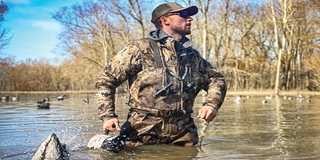
Photo Higdon Outdoors
In many southern and central states, extended periods of balmy weather have been the norm during the past few waterfowl seasons. While hunters almost universally dislike bluebird days, opportunities still exist even in shirtsleeve weather. In fact, savvy hunters can use these conditions to their advantage if they choose the right spot to hunt.
Jon Walczak, a Mossy Oak pro-staffer who hunts ducks on Marylands Eastern Shore and adjacent Chesapeake Bay, pursues the following strategy for ducks on windless days. The first thing I do is get off the big water and look for a spot that isnt as dependent on wind to move my decoys, he explains. We have a hole along a river that is very narrow and has tall trees on both sides. The water is only about 65 to 70 yards across. This spot is sheltered by the trees so it really doesnt matter if the wind is blowing or not.
Walczak fills much of the open water with floating decoys, leaving an open landing zone directly in front of his blind. To put lifelike ripples on the water, Walczak deploys six or more Higdon Pulsators in his spread as well as a jerk cord attached to several decoys. Ducks passing overhead see a narrow pocket of water packed with decoys and churning with movement.
I dont have any decoys sitting still because of the ripples created by the Pulsators and the jerk cord. The entire spread looks like its moving, Walczak says. And with the narrow gap in the trees, once the ducks get into the hole to check out the motion, its tough for them to get out. This is a spot we reserve for days when we know the weather isnt going to help us, and it often produces.

Photo Jim Thompson
Walczak has also developed specialized tactics for hunting Canada geese on calm days. Using V-boardsY-shaped wooden frames that each hold three Canada goose silhouettes facing in different directionsWalczak bunches most of his decoys in a tight group around his pit blind. He then runs a long line of V-boardsset side by side in pairs100 yards out from the main group.
Its almost like a longline used for diving ducks, Walczak explains. Approaching geese typically follow the line all the way to the main body of decoys surrounding the blind.
The lack of wind doesnt seem to bother approaching geese due to the landing strip effect created by the line of decoys. Employing this spread, along with subtle, relaxed calling, Walczak is able to guide approaching geese into close shooting range. The big clump of decoys is what they are looking at the whole time, he says. As they come down the line, they drop altitude and often end up right in front of our blind.
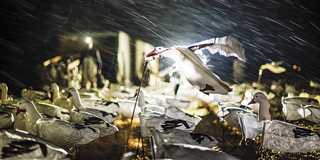
Photo Seth Dortch
Heavy rainfall and flooding can dramatically change the availability of waterfowl habitat on the landscape, and it can happen quickly. Freshly flooded agricultural fields and moist-soil habitats become smorgasbords for ducks and geese during and immediately after heavy rains. Kile Jones, Higdon Outdoors sales account manager and two-time World Goose Calling Champion, turns his calling up a notch for both ducks and geese following a deluge.
I really try to be more aggressive when there is a lot of new water around me, Jones says. I dont go to 100 percent traffic-style calling, but you have to work harder to get their attention because they are actively looking for new food sources.
Jones has observed that Canada geese become more talkative in these conditions, and he uses that to his advantage. I like to blow a series of quick spit notes, reverse double clucks, and regular double clucks to imitate birds competing for food. That creates a lot of excitement, which can trick honkers into finishing at your feet, he says.
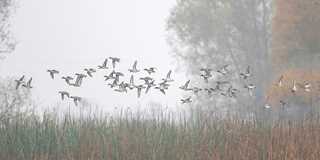
Photo Dean Pearson
Captain Corey Gradwohl, a waterfowl and fishing guide with Hook and Reel Charters in southeast Louisiana, knows foggy conditions. With warm water temperatures along the Gulf Coast, even a slight cold front can put a dense layer of fog over the marsh.
I hunt on a lot of foggy days, which are pretty common down here, Gradwohl says. I dont do anything different with my decoys because the ducks cant see them well anyway, but I do change the way I call in heavy fog.
Specifically, Gradwohl increases the frequency of his calling to attract ducks passing overhead above the fog. Every couple of minutes, Ill just start calling. This is the best way to let the ducks know youre there. I use a mallard call, but you can use a pintail whistle or even a gray duck [gadwall] call, he says. You just want to create enough sound for the ducks to know youre there.
Gradwohl notes that ducks are very good at pinpointing your position by sound in low-visibility conditions, so hunters should be prepared to shoot at all times. You might call a few times, and a flock will just pop out of the fog and drop into the decoys, he says. Make sure everyone in the blind is ready and paying attention. Hunting in the fog can provide fast action.

Photo Kevin Anderson
When a forecast for a polar vortex scrolls across your weather app, its time to act. Massive cold fronts often trigger mass movements of ducks and geese, providing some of the best hunting of the season. While most hunters head directly to the blind in such conditions, Mario Friendy, vice president of brand innovation, marketing, and sales at Final Approach, turns his attention to preparation.
When we see that a big cold front is coming and the potential for a hard freeze is in the forecast, we begin preparing for the next week, not just one hunt, Friendy explains.
Well before the arctic blast arrives, Friendy begins implementing his freeze-up plan, which includes removing any existing decoys placed around his blinds. He also deploys Ice Rippersmachines that keep water open by circulating warmer currents from the bottom.
We pick up all our decoys in areas that will freeze, Friendy says. As the temperature plummets and surrounding waters lock up tight, the Ice Rippers keep a hole open in front of our blinds.
Friendy believes in using large numbers of decoys during cold snaps. He almost completely fills open water with floating decoysleaving only a small landing zone downwind from his blindsand places full-body decoys on the ice surrounding the hole. Concentrations of birds crowded on small patches of open water are what ducks are looking for, so thats what we try to represent with our decoys, he says.
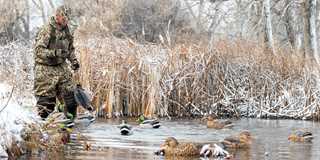
Photo dougsteinke.com
Waterfowlers often pray for severe cold fronts and wintry weather to push waterfowl down from the north, but large movements of waterfowl can also come from the south during a sudden warming trend. Moreover, great shooting is often available during transition periods, when wetlands and flooded fields freeze overnight and then thaw during the day. This limits food availability for waterfowl, making the birds more eager to decoy when shallow feeding habitats open up.
A thaw is usually accompanied by a strong south wind, which often carries a reverse migration, Jones says. Ducks and geese moving back into these partially frozen areas are looking to feed, so any open water with a food sourcelike a recently thawed flooded grainfieldis going to be a great spot.
When hunting these habitats, Jones uses large numbers of decoys to resemble a concentration of waterfowl packed into a productive feeding spot. Once I find some open water, Ill load the area with decoysfloaters, shells, and full bodies. This not only looks natural but also increases the visibility of my spread, he says.
Jones also calls loudly and often to passing flocks, knowing that waterfowl dont have many other options on the landscape. These birds are looking for company, so you want to make sure they see your decoys, he says. Of course, some flocks will react differently to calling than others, but you want to make enough noise to draw birds in for a closer look at
your spread.
While waterfowl can be especially susceptible to calling and decoys under these conditions, Jones cautions hunters not to skimp on concealment. I try to get as close to the decoys as possible using natural cover, but you still have to be well hidden, he explains. Setting a big spread, calling aggressively, and having great cover will often put birds right in your lap.
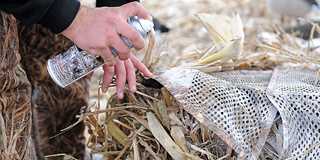
Photo Travis Mueller, Avery Outdoors
In west-central Minnesota, hunting in the snow is a fact of life for waterfowlers. Bryant Johnson, marketing manager for Real Avid outside Minneapolis, relishes the days when the snow flies. When snow starts coming down hard, we make a few quick adjustments in how we hunt, he says. The first thing we do is place our decoys closer together in a big bunch. That makes our spread a lot easier to see for birds navigating through the snow. Their ability to see decreases in these conditions, so you want to have the most visible footprint possible.
Many hunters call more aggressively during a snowstorm, but Johnson cautions that you have to be careful not to overcall in those conditions. As the visibility deteriorates, geese can get really close before you know it, and you dont want to blow them out, Johnson says. The birds are typically looking for a quick meal when the snow is piling up, so once they see your spread, they often come right in.
Concealment is also an important consideration when snow covers the landscape. Johnson carries aerosol cans of environmentally friendly artificial snow, commonly used to decorate Christmas trees, to cover his layout blinds during a sudden snow squall. We may be in a muddy field that is picking up snow and our blinds might look out of place for the first hour or so, Johnson says. This store-bought snow, which can be bought at many local retailers or online, lets us cover up any brown spots and blend our layouts into the white background quickly.
Ducks Unlimited uses cookies to enhance your browsing experience, optimize site functionality, analyze traffic, and deliver personalized advertising through third parties. By continuing to use this site, you agree to our use of cookies. View Privacy Policy